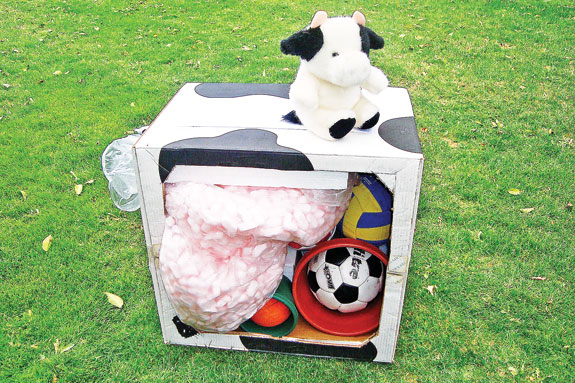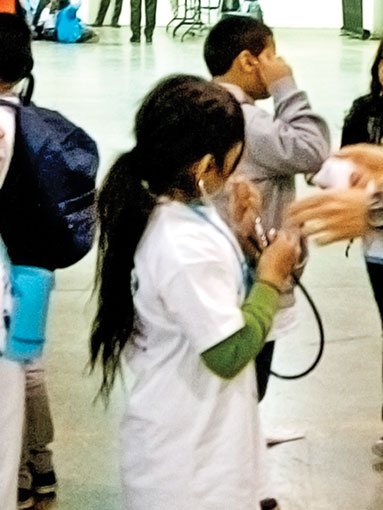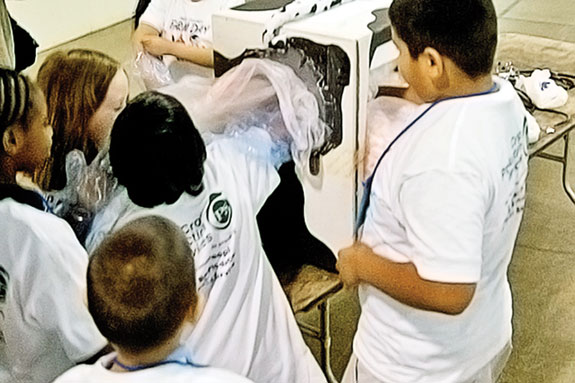Sometimes, pictures just aren’t enough. For several years, staff members at University of California – Davis’ Veterinary Medicine Teaching and Research Center took pictures of vets doing their jobs to area schools and events to show students about the field. But they wanted to do more – so they built a cow – out of cardboard. The cardboard cow, affectionately known as CC, has opened up a new level of “hands-on” learning for youngsters in central California.
“‘Thank you for letting them touch things.’ That’s what teachers say to us,” says Grant Jones-Wiebe, who helped design CC with fellow VMTRC staffers Jennifer Crook and Jared Parko.
“I know kids need this,” Jones-Wiebe says. “When our hands can work with the stuff that we have only seen and heard about, learning happens and then creativity can occur.”
Jones-Wiebe says Crook had already created a backdrop filled with pictures of the kinds of science careers available through the college.
She had clean cow bones and see-through models of cows to show kids in classrooms around the community near campus.
Jones-Wiebe joined her tour and asked, “What else can we do?” Parko had seen a box-cow, which contained a fistula, at the Michigan State campus. During Halloween, brave students could reach through the fistula and find candy.

That got the cogs in Jones-Weibe’s head spinning. Within about 30 minutes, he’d found an old Gateway computer box – conveniently already decorated with Holstein-like spots.
Putting the box on its side, he cut a window into the box. Then he used Styrofoam packing peanuts and a clear plastic bag to create intestines, four different size balls for the stomachs and a stuffed, toy cow to simulate a baby calf.
Once built, CC went on the road. Each year, literally hundreds of grade school students make a “vet visit” to CC.
In a presentation that lasts about nine minutes, Crook and Jones-Weibe take a pretend call from a dairy. Using both English and Spanish, the vet-school staff determines they need to check on a cow, but first have to train some new vets.

The children are given stethoscopes and asked to find their own heartbeat. It’s at that point, Jones-Weibe says, students’ eyes start to open wide.
“When they hear their own heartbeats, you see them listening and they get big smiles on their faces. They look up at me and say, ‘I can hear it’ and it’s like they suddenly realize, ‘I’m alive,’” he said. “That’s the aha moment.”
The kids then don a vet glove and reach into CC through an opening under her tail. They can feel her intestines, her stomachs and the “calf” inside her.
“They love to find the calf,” Jones-Weibe said. “They love it.”
Once they have palpated at the cow, they have to “disinfect” using clean wipes and then they can talk about the interests in school that might translate into a career in veterinary sciences.
Crook says she’s put a lifetime love of learning to work in her displays for the VMTRC. She’s been doing presentations on both the cow vet visit and a dairy goat visit for about nine years.

She grew up in the area and developed an appreciation for agriculture through FFA. She said the “learn by doing” model is important to her.
“My parents are schoolteachers, so I take my teaching style from them. I felt children learn best by doing, so I created hands-on presentations to get the kids involved.
The kids light up when they get to touch, feel, pet and play with the exhibits,” Crook said.
Jones-Wiebe’s bosses liked what they’ve seen and have appointed him as the vet center’s official ambassador.
“Grant’s main responsibilities are to provide IT support to the VMTRC. However, Grant has been the primary host for tours here at the VMTRC for many years,” says VMTRC’s Assistant Director Carlene Salonites.
“Providing tours and learning opportunities to these various groups is an important part of the service and outreach mission not only for the VMTRC, but also for the School of Veterinary Medicine.
Grant does an excellent job of representing the center and we constantly receive compliments from visitors. They love his enthusiasm! Grant also knows six languages, which definitely comes in handy when meeting with international groups.”
Jones-Wiebe isn’t done yet. He and his co-workers are in the process of developing another cardboard cow. This one will feature the cow’s lungs. PD
PHOTOS
“I know kids need this. When our hands can work with the stuff that we have only seen and heard about, learning happens and then creativity can occur.” Photos courtesy of Grant Jones-Wiebe .
Click here to jump over to Proud to Dairy to read Karma's fun attempt at recreating the cardboard cow.

Karma Metzler Fitzgerald
Contributor
Progressive Dairyman magazine





